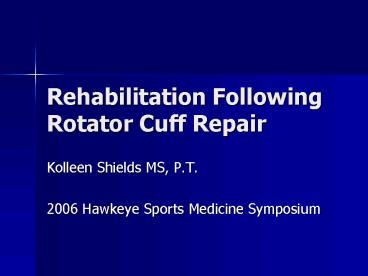Rehabilitation Following Rotator Cuff Repair - PowerPoint PPT Presentation
1 / 47
Title: Rehabilitation Following Rotator Cuff Repair
1
Rehabilitation Following Rotator Cuff Repair
- Kolleen Shields MS, P.T.
- 2006 Hawkeye Sports Medicine Symposium
2
Terminology
- Partial Rotator Cuff Tears
- Full Rotator Cuff Tears
- Small (lt 2 cm)
- Medium (2-5 cm)
- Large (gt 5 cm)
- Massive (involves 2 or more tendons)
3
Open Repairs vs. Arthroscopic
- Larger incision
- Deltoid detachment
- More post-op pain
- Inpatient stay for pain control
- Smaller incision
- Less post-op pain
- Outpatient procedure
- Pain is not a good guide for rehab
4
Information essential in designing a
rehabilitation program
- Nature of injury (type of tear)
- Extent of surgical repair
- Restrictions set by physician
- Restrictions as understood by client
- Concurrent medical conditions
- Pre-op level of function and mobility
5
Immediate post-operative goals (0-2 weeks)
- Control pain/swelling
- Cryotherapy
- (Speer et al. J Shoulder Elbow Surg. 1996)
- Medications as prescribed
- Use of sling to limit shoulder movement
- Sleep position
6
Immediate post-operative goals (0-2 weeks)
- Early protective passive motion
- Pendulums
- Passive elevation (90-120 degrees)
- Table slides
- Pulleys
- Passive external rotation (0-20 degrees)
- Elbow, wrist, hand active motion
- Isometric grip strengthening
- Periscapular isometrics
7
Early ROM Exercises
8
Table Slides
9
Immediate post-operative precautions
- Avoid extension movements beyond plane of body (4
weeks) - Avoid any active lifting of the arm
(elevation/abduction 6 weeks) - Avoid active external rotation (4-6 weeks)
10
Posture
- Coracoacromial ligament and attachment to
acromion form a roof under which the
supraspinatus tendon, the biceps tendon and
subacromial bursa must pass during elevation or
abduction of the arm. - At approx. 70-120 deg of active glenohumeral
elevation, the greater tuberosity approaches the
roof - Rounded shoulder posture narrows potential space
of the roof, thus making it more likely that
impingement may occur with elevation of the arm
11
Postural sets
12
Progressive Rehabilitation (2-4 weeks)
- Continue pendulums and table slides
- Passive elevation (120-135 deg)
- Passive external rotation (20-35 deg)
- Initiate pulleys
- Tendon tissue healing requires the load across
the tendon to be minimal for the first 4 weeks
13
Advanced passive motion
14
Progressive Rehabilitation (4-6 weeks)
- Continue passive motion exercises
(elevation135-150 deg, external rotation30-45
deg) - Add bilateral extension motion with cane
- Add internal rotation for posterior capsule
stretch
15
(No Transcript)
16
Progressive Rehabilitation (6-8 weeks) A.A.R.O.M
- Gradually introduce controlled stretches across
the healing tendon during the maturation process.
Tissues need to see progressively increasing
loads. - A.A.R.O.M for elevation progression of wall
walking, assisted supine cane exercises, supine
bilateral arm raise
17
(No Transcript)
18
Assisted wall walking
19
Progressive Rehabilitation (6-8 weeks) A.A.R.O.M
- A.A.R.O.M for internal rotation cane behind
back, towel stretch, clasp hands behind back - A.A.R.O.M diagonal supine with cane
- A.A.R.O.M extension standing
- A.A.R.O.M for external rotation (35-55 deg)
- Continued wall walking
- Low level isometrics
20
(No Transcript)
21
Progressive Rehabilitation (8-12 weeks)
- Continue with range of motion exercises working
towards full functional mobility (mobilization?) - Should be able to raise arm above head
- Add light resistance (cream/yellow) therabands
- Bilateral extension
- Bilateral forward flexion (30 deg)
- Bilateral external rotation
- Triceps
- Scapular retraction
- Unilateral internal rotation
- Abduction/Adduction
22
(No Transcript)
23
Progressive Active Elevation
24
Isometrics
25
Active Assistive Range of Motion
26
Progressive Theraband
27
(No Transcript)
28
(No Transcript)
29
Progressive Rehabilitation (8-12 weeks)
- Side lying external rotation (light weights)
progressing from arm at side to arm away from
side - Periscapular prone strengthening with weights
- Tricep strengthening
- Bicep curls
30
Periscapular Strengthening
31
Side Lying External Rotation
32
Triceps/Biceps Strengthening
33
Advanced Strengthening (12 weeks-6 months)
- Progression of theraband exercises
- Add closed chain exercises
- PREs for external rotation, elevation, abduction
34
Cuff Strengthening in Abduction
35
Progression of Active Exercises
36
Progression of Stabilization Exercises
37
Highest Level Strengthening May Include
- Full range strengthening activities
- Body blade
- Therapeutic ball activities
- Plyometric activities
- Return to sport drills
38
Full Range Strengthening
39
(No Transcript)
40
(No Transcript)
41
Therapuetic Ball Exercises
42
Body Blade
43
Plyometrics
44
Rehabilitation Following Rotator Cuff Tears
45
Initial Goals
- Control pain (cryotheraphy, medication, sling)
- Begin gentle, passive/active assistive range of
motion exercises - Sleep position
- Rest arm
46
Goals of Therapeutic Exercise
- Improve strength of surrounding musculature in
order to regain functional use of the arm - Proceed slowly and use pain as a guide.
- Partial RCT can progress to full thickness tears.
47
Return to function































